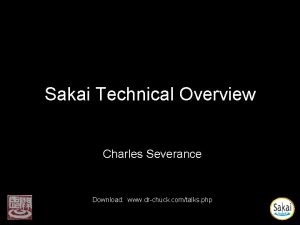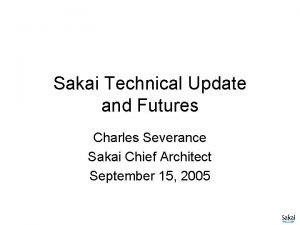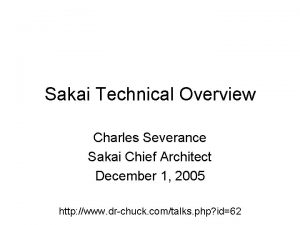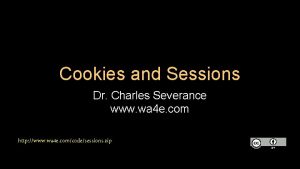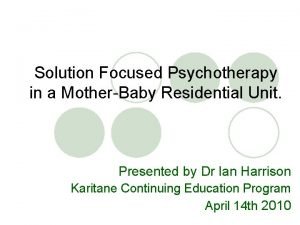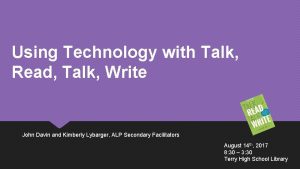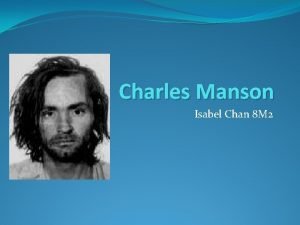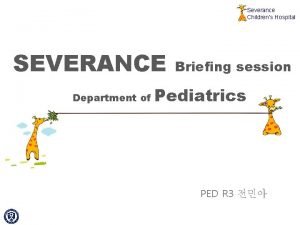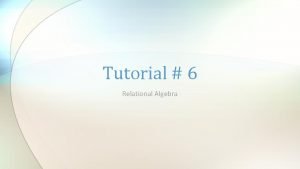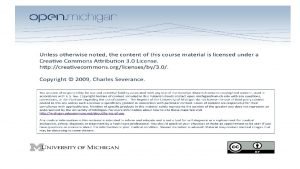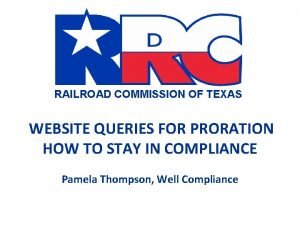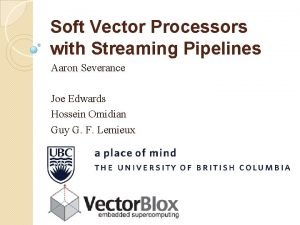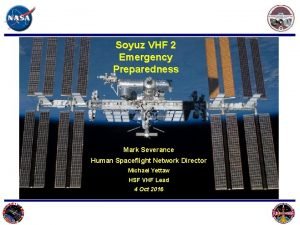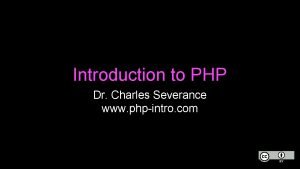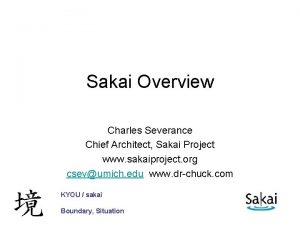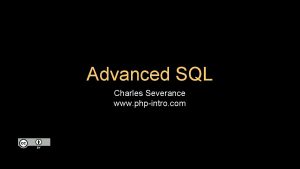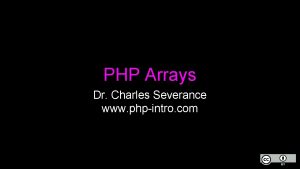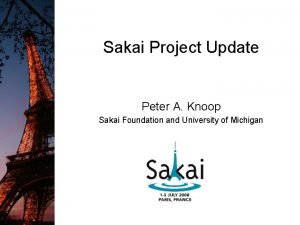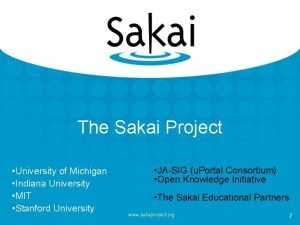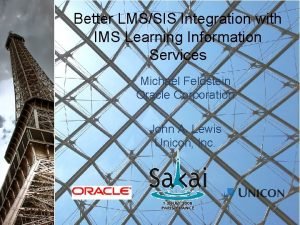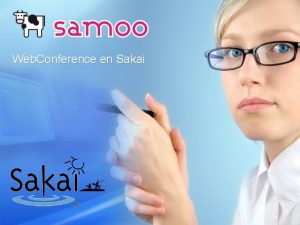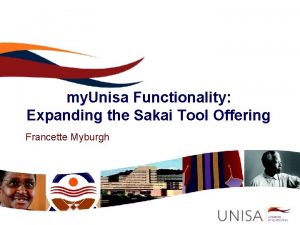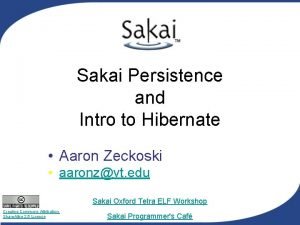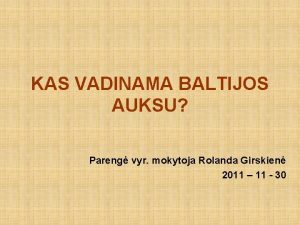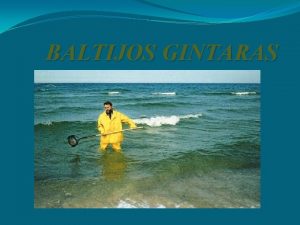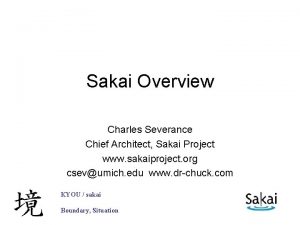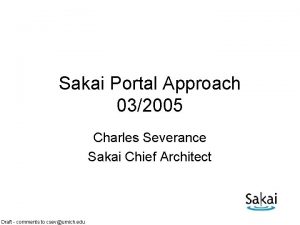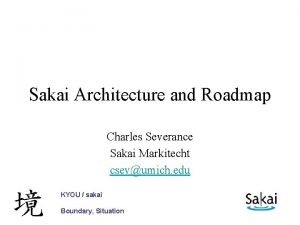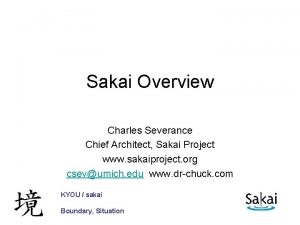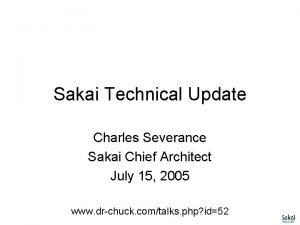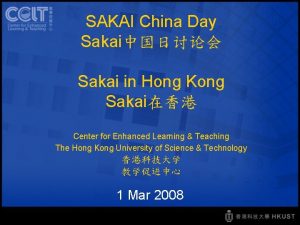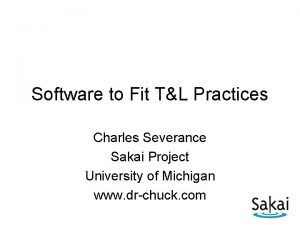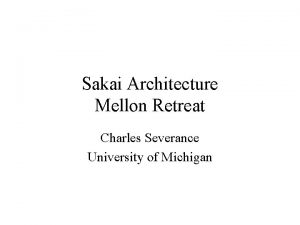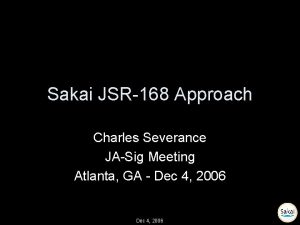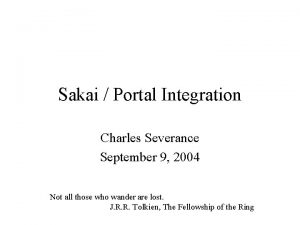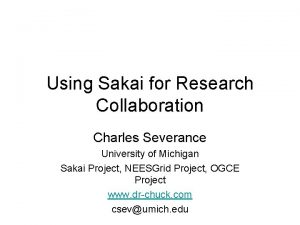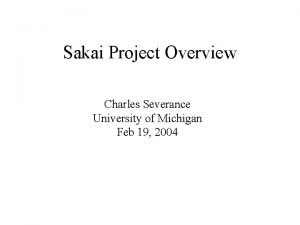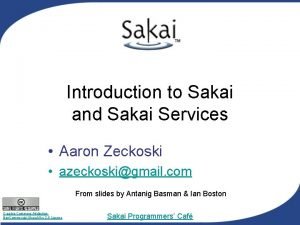Sakai Dr Charles Severance Note This talk was




































- Slides: 36

Sakai Dr. Charles Severance Note: This talk was given at the Apple WWDC on 6/7/2005 http: //developer. apple. com/wwdc

What is Sakai? • A project—an initial grant for two years • A community—an emerging group of people and resources supporting the code and each other, realizing large scale Open Source efficiencies in Higher. Ed • An extensible framework for building collaborative—provides basic capabilities to support a wide range of tools and services—teaching and research • A product with: ■ ■ A released bundle of the framework and A set of tools—written and supported by various groups and individuals—which have been tested and released as a unit

Why You Should Care • Education Institutions and Customers ■ Deploy on Mac OS X Server, Xserve ■ Extensibility enables innovation faculty and staff ■ Keep control of the software used for teaching, learning, and collaboration • Commercial and Open/Community Source Developers ■ ■ Integrate your own code, widget to create Mac OS X, QT/MPEG workflows Provide consulting, technical support, local integration, etc. • Content Providers ■ Allows entry to campuses which formerly build their own learning

The Sakai Project Funding and Initial Institutional Partners http: //developer. apple. com/wwdc

The Sakai Project The University of Michigan, Indiana University, MIT, Stanford, the u. Portal Consortium, and the Open Knowledge Initiative (OKI) are joining forces to integrate and synchronize their considerable educational software into a preintegrated collection of open source tools. Sakai Project receives $2. 4 million grant from Mellon

Sakai Funding • Each of the 4 Core Universities Commits ■ 5+ developers/architects, etc. under Sakai Board project direction for 2 years ■ Public commitment to implement Sakai ■ Open/Open licensing—“Community Source” • So, overall project levels ■ $4. 4 M in institutional staff (27 FTE) ■ $2. 4 M Mellon, $300 K Hewlett ■ Additional investment through partners


Black Board In du st ry Commercial Sh ak eo u t Consolidation In a way, the Sakai “Project” is just a “blip” in the evolution of an Open Source CLE Home Grown Co Co nso or lid di at na io tio n n Web. CT ? Sakai Project 1995 2002 2004 2007

The Sakai Community Close coordination for two years to quickly build the critical mass for open source enterprise Collaborative Learning Environment http: //developer. apple. com/wwdc

Sakai Organization Joseph Hardin Sakai PI Board Chair Sakai Board UM, IU, Stanford, MIT, UCB, Foothill, OKI, u. Portal, Hull (UK) Product Requirement s Team Architecture Team Sakai Educational Partners Project Management

Sakai Educational Partners—Feb 1, 2005 • Arizona State University • Boston University School of Management • Brown University • Carleton College • Carnegie Foundation for Advancement of Teaching • Carnegie Mellon University • Coastline Community College • Columbia University • Community College of Southern Nevada • Cornell University • Dartmouth College • Florida Community College/Jacksonville • Foothill-De Anza Community College • Franklin University • Georgetown University • Harvard University • Johns Hopkins University • Lubeck University of Applied Sciences • Maricopa County Community College • Monash University • Nagoya University • New York University • Northeastern University • North-West University (SA) • Northwestern University • Ohio State University • Portland State University • Princeton University • Roskilde University (Denmark) • Rutgers University • Simon Fraser University • State University of New York Stockholm University SURF/University of Amsterdam Tufts University Universidad Politecnica de Valencia (Spain) Universitat de Lleida (Spain) University of Arizona University of California Berkeley University of California, Davis University of California, Los Angeles University of California, Merced University of California, Santa Barbara University of Cambridge, CARET University of Cape Town, SA University of Colorado at Boulder University of Delaware University of Hawaii University of Hull University of Illinois at Urbana-Champaign University of Melbourne, Australia University of Minnesota University of Missouri University of Nebraska University of Oklahoma University of Texas at Austin University of Toronto, Knowledge Media Design Institute University of Virginia University of Washington University of Wisconsin, Madison Virginia Polytechnic Institute/University Whitman College Yale University

Sakai Commercial Affiliates The Sakai Educational Community License is BSDlike and allows complete flexibility in terms of the creation of and licensing of derivative works. This allows different commercial companies to interact in different ways without any limitations imposed by license.

Sakai Meetings • Provide a forum for the core and the SEPP to interact and for the SEPP members to interact with one another ■ June 2004—Denver Colorado (180) (Members only) ■ December 2004—New Orleans (200+) (Members only) ■ June 8 -14—Baltimore (400+ expected) ■ ■ Community Source Week ■ u. Portal, Sakai, OSPI December TBD—Austin, TX (Public)

Sakai’s Future • Initial grant ends December 2005 • Transition to Community Source ■ The SEPP is renamed “Sakai” (1 -2 Million/year) ■ Governance is merit-based (like Apache) ■ Core elements of Sakai software pretty stable ■ ■ ■ Small Community funded team (~10) to keep the core maintained and slowly evolving Most new development will be done outside of the core Significant continued in-kind resources Michigan, Indiana, Yale, Foothill, Stanford, and Berkley

The Sakai Product A Collaborative Learning Environment—Suitable for use in Teaching and Learning, Research Collaboration, and ad Hoc Group Communication. http: //developer. apple. com/wwdc

Placing the Sakai Product A Collaboration and Learning Environment Teaching And Learning Collaboration

Sakai Releases Enterprise Quality Teaching and Learning and Collaboration Sakai 1. 0 Jan 2004 Sakai 1. 5 Sakai 2. 0 Jan 2005 Collaboration Teaching and Learning Sakai 2. 1 Jan 2006 Enterprise “suitability”

Sakai 1. 0 Tools • Announcements • Assignments • Chat Room • Threaded Discussion • Drop Box • Email Archive • Message Of The Day • News/RSS • Preferences • Resources • Schedule • Web Content • Worksite Setup • Web. DAV

Sakai 1. 5 Tools • Samigo—QTI compliant assessment engine (Stanford) • Syllabus Tool (Indiana) • Context Sensitive Help (Indiana) • Presentation Tool (SEPP) • Portfolio Tool—OSPI (R-Smart) (separate release)

Sakai 2. 0 Tools • Completely re-written Kernel (UM / MIT) • Melete - Online classroom lesson editor (Foothill) • Profile Tool (Indiana) • Grade Book (UC Berkeley / MIT )

Demo Setting up a Worksite for Collaborative Group Projects http: //developer. apple. com/wwdc

Sakai in Production • University of Michigan ■ September 2004 • Indiana University ■ January 2005 • Yale University ■ January 2005 • Etudes / Foothill ■ April 2005

Sakai Adoption Plans • Boston University School of Management • Carleton • Columbia University • Johns Hopkins University • Lueck University of Applied Sciences, • University of California, Los Angeles • Massachusetts Institute of Technology • Northwestern University • Stanford University • University of California, Berkeley • University of Lleida, Spain Germany • University of California, Merced • University of Cape Town, SA • University Fernando Pessoa, Portugal • University of Missouri • University of Virginia • Whitman College Type “Sakai Adoption Plans” into Google

The Sakai Framework The need to satisfy the often conflicting goals of ease of use, ease of expansion, configuration flexibility, environmental portability and rock-solid production reliability suitable for enterprise deployment. http: //developer. apple. com/wwdc

Sakai Foundational Technologies Java 1. 4 Apache - SSL, mod_jk, WEBISO, virtual hosting JBoss and Tomcat 4. 1 Included in OS/X Server Sakai Tomcat 5. 5 Spring Hibernate Java Server Faces Velocity (legacy) My. Sql 4. 1 Oracle is *available* for X/Serve Oracle Sakai consists of technologies chosen to be common in Java Enterprise Environments. Sakai requires Tomcat 5. x but can make use of all of the open source elements included in Mac OS X Server.

Service Oriented Architecture Browser Presentation Code My Monolithic Code Persistence Service Interface (i. e. API)

Sakai Application Framework SAF—Presentation Services Tool Layout (JSP) Framewor k Tool Code (Java) Application Services SAF—Common Services SAF—Kernel

Sakai Presentation Services <sakai: view_container title="#{msgs. sample_title}"> <sakai: tool_bar_item/> </sakai: tool_bar> <sakai: instruction_message value="#{msgs. sample_one_instructions}" /> <sakai: group_box title="#{msgs. sample_one_groupbox}"> <h: input. Text value="#{My. Tool. user. Name}" /> <sakai: date_input value="#{My. Tool. date}" /> <sakai: button_bar_item action="#{My. Tool. process. Action. Do. It} value="#{msgs. sample_one_cmd_go}" /> </sakai: button_bar>

Sakai Service Providers • Common Services are localized SAF—Common Services using plug-ins Realm. Provider ■ Course. Management. Provider • These will be expanded ■ OKI OSID Based Providers • Plug-ins do not replace the persistence, they are consulted in order to populate Sakai structures Course Provider ■ Role Provider User. Directory. Provider User Provider ■

Sakai And OKI • OKI is one of the founding partners of the Sakai project • The Sakai Framework's use of OSIDs focuses on using OSIDs to integrate enterprise information into Sakai—this is expected for the 2. 1 release • The Sakai Common APIs are designed based on adopting the design principles and terminology of the OSIDs (Agent, Asset, etc). This is done so that the Sakai APIs and OSIDs will remain in close alignment and each can benefit from innovations of the other • A number of tools including Samigo and Presentation use OSID APIs internally in Sakai 1. 5 and 2. 0

IMS Tool Portability Group • To work on ‘interoperability’ between and among CMS’s/CLE’s • Focus is on making tools portable between systems (Sakai, Web. CT, and Blackboard) • Established to further the discussion with commercial and other CMS/CLE providers • Will use web services and IFRAMES • Will show working demonstration at the July 2005 Alt-I-lab with Samigo in Sakai, Web. CT, and Blackboard

Sakai, IMS, and Web Services HTML/HTTP Header Button Button Web Services Tool Area 1 6 Web Services Launch Control 7 Application Code 4 2 Session And Services Bootstrap 3 External Web Application CLE Environment 5

Summary or Why You Cared • Education Institutions and Customers Sakai provides FOSS enterprise-quality software for teaching, learning ■ By adopting Sakai, institutions gain control over their own destiny w. r. t. teaching and learning on their campuses ■ • Commercial and Open/Community Source Developers Sakai’s licensing is very commercial-friendly—many opportunities to add value to Sakai profitably ■ Sakai’s founding principles are to engourage commercial affiliates and support those affiliates ■ • Content Providers Sakai is taking a leadership role and working with OKI and IMS to develop cross-LMS standards and provide a reference implementation for those standards ■ Allows content providers to build to a single standard and deploy ■

Sakai and Apple • Among the developer team, 70% develop on Apple systems ■ More dev-QA is done on Apple OS X than any other system : ) • Sakai’s internal collaboration server runs on Mac OS/X Server ■ collab. sakaiproject. org • Advantages of Mac OS/X and XServe when running Sakai ■ Simple operating system maintenance (patches, etc) ■ Java pre-installed and kept up to date ■ Probably the ideal platform for small installations where there is not a dedicated system administrator

Sakai: More Information And Next Steps • Main site: www. sakaiproject. org ■ Bugs: bugs. sakaiproject. org • Sakai-wide collaboration area collab. sakaiproject. org ■ sakai-dev@sakaiproject. org ■ sakai-user@sakaiproject. org ■ • Maclearningenvironments. org Integrating Apple technologies into new Learning Environments ■ Open and Community Source Learning Infrastructure Projects ■ Mac OS X Server implementations and deployments of Sakai ■ Community Built on Sakai ■

 Severance télécharger
Severance télécharger Charles severance sakai
Charles severance sakai Charles severance sakai
Charles severance sakai Dr. charles severance
Dr. charles severance Dr charles severance
Dr charles severance Amateurs talk tactics professionals talk logistics
Amateurs talk tactics professionals talk logistics The words use are not
The words use are not Talk, read talk write template
Talk, read talk write template Signal words examples
Signal words examples Debit note format
Debit note format Difference between note making and note taking
Difference between note making and note taking A simple discount note results in
A simple discount note results in Note taking and note making
Note taking and note making Financial documents order
Financial documents order Difference between note making and note taking
Difference between note making and note taking Debit note meaning
Debit note meaning Charles manson childhood
Charles manson childhood Severance children's hospital
Severance children's hospital Company database schema
Company database schema Severance network
Severance network Texas rrc wellbore query
Texas rrc wellbore query Severance streaming
Severance streaming Mark severance
Mark severance Var_dump in php
Var_dump in php Severance téléchargement direct
Severance téléchargement direct Severance
Severance Severance intro
Severance intro Sakai foundation
Sakai foundation Joseph sakai
Joseph sakai Sakai claremont colleges
Sakai claremont colleges Sakai dli
Sakai dli Deü sakai
Deü sakai Sakai web
Sakai web Unisa application tool
Unisa application tool Aaron sakai
Aaron sakai Kas vadinama baltijos auksu
Kas vadinama baltijos auksu Sukietėję sakai
Sukietėję sakai
